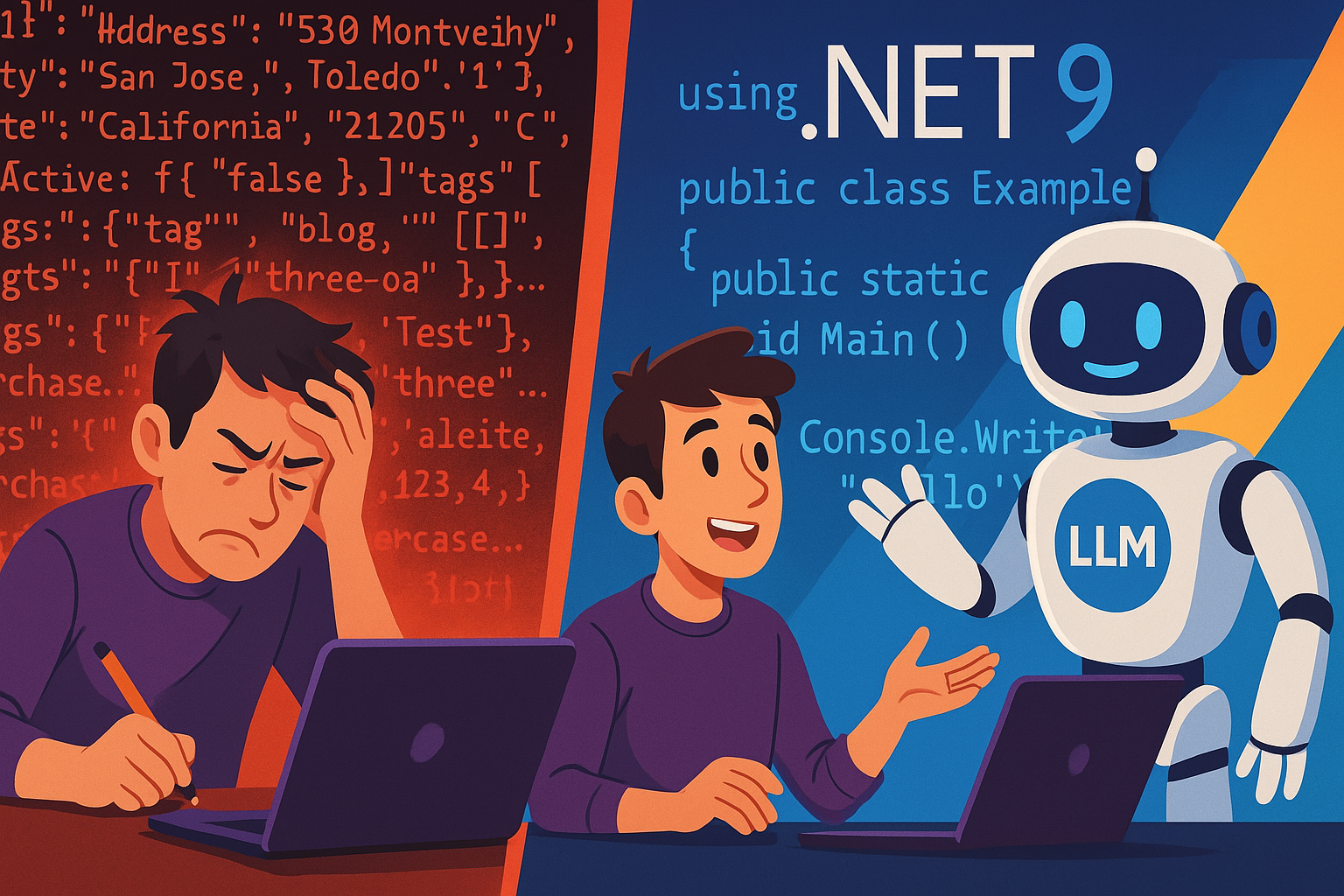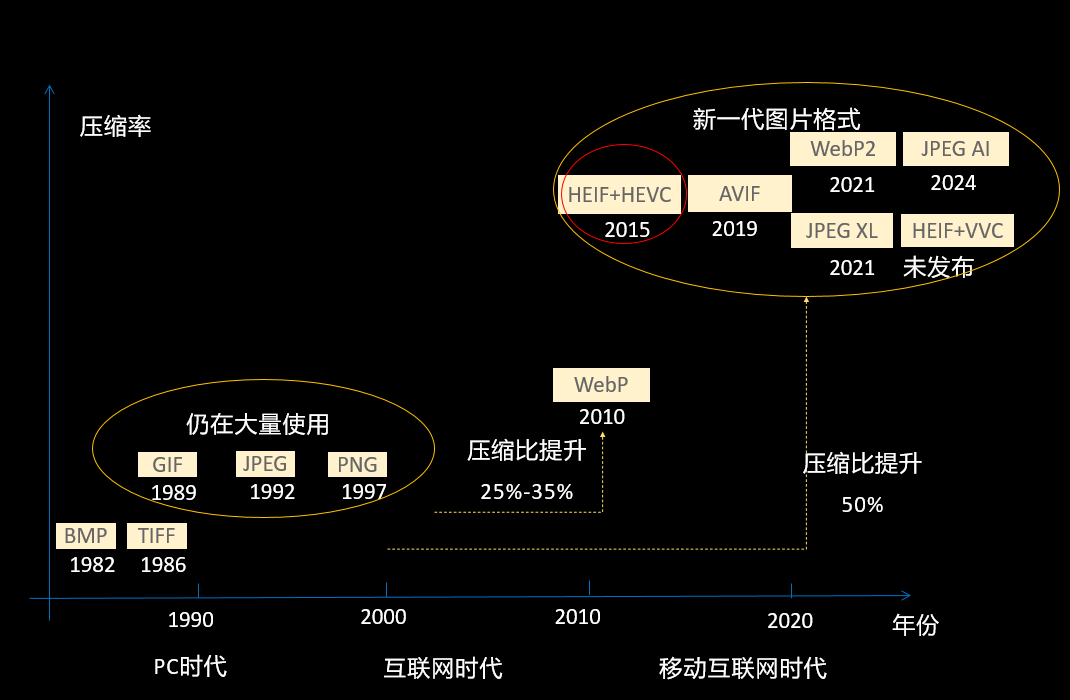引言
.NET 9 迎来了一项备受期待的功能更新:对JSON Schema的原生支持。这一新增功能极大地简化了JSON Schema的生成与使用。JSON Schema作为一种描述JSON数据结构的标准格式,能够帮助我们有效地验证数据结构和类型。尤其在与大语言模型(LLM)进行交互的场景中,它扮演着至关重要的角色,可以精确定义模型输入与输出的数据格式,从而确保通信的准确性和可靠性。

.NET 9 的新利器:JsonSchemaExporter
让我们从一个简单的例子开始。在.NET 9中,我们可以利用 System.Text.Json 命名空间下的新工具 JsonSchemaExporter,轻松地将一个C#类转换为对应的JSON Schema。
首先,我们定义一个名为 Book 的C#类。这个类包含三个属性:Title、Author 和 PublishYear。其中,Title 是一个必需的字符串属性,Author 是一个可空字符串属性,而 PublishYear 是一个整数。
// 定义一个名为 Book 的类 public class Book { // 必须的字符串属性 Title public required string Title { get; set; } // 可选的字符串属性 Author,允许为 null public string? Author { get; set; } // 整数属性 PublishYear public int PublishYear { get; set; } } 接下来,在主程序中,我们只需调用 JsonSchemaExporter.GetJsonSchemaAsNode 方法,并传入我们的 Book 类型,即可生成其JSON Schema。
class Program { static void Main() { // 使用 JsonSchemaExporter 为 .NET 类型生成 JSON schema var schema = JsonSchemaExporter.GetJsonSchemaAsNode( JsonSerializerOptions.Default, typeof(Book) ); // 输出生成的 JSON schema Console.WriteLine(schema); } } 运行上述代码,我们将得到以下JSON Schema输出:
{ "type": [ "object", "null" ], "properties": { "Title": { "type": [ "string", "null" ] }, "Author": { "type": [ "string", "null" ] }, "PublishYear": { "type": "integer" } }, "required": [ "Title" ] } 这个特性使得我们能够以标准化的JSON Schema形式来表示一个.NET类型,这对于实现远程过程调用(RPC)或与OpenAI、Google Gemini等AI服务进行集成时非常有用。
实战:结合OpenAI实现结构化输出
我们知道,从 gpt-4o-0806 开始,OpenAI便支持了通过JSON Schema来约束模型的输出格式。这个功能极大地便利了开发者,尤其是在需要模型返回复杂数据结构时。然而,手动编写和维护这些JSON Schema既繁琐又容易出错。现在,借助.NET 9的 JsonSchemaExporter,这个过程变得前所未有的简单。
注意
:以下示例需要依赖Azure.AI.OpenAINuGet包 2.2.0 或更高版本。
让我们来看一个实际的例子。假设我们需要让大模型分析一段关于篮子里放球、取球的描述,并返回一个包含各种颜色球类数量的结构化数据。
首先,定义我们期望的输出数据结构 BallCounts 类:
public class BallCounts { public string? Think { get; init; } // 模型的思考过程 public int Red { get; init; } public int Blue { get; init; } public int Yellow { get; init; } public int Green { get; init; } public int Confidence { get; init; } // 模型对答案的置信度 } 然后,在调用模型时,我们可以将这个 BallCounts 类型动态生成JSON Schema,并直接传递给 ChatCompletionOptions 的 ResponseFormat。
// 初始化OpenAI客户端 OpenAIClient api = new AzureOpenAIClient(new Uri($"https://{Util.GetPassword("azure-ai-resource")}.openai.azure.com/"), new AzureKeyCredential(Util.GetPassword("azure-ai-key"))); ChatClient cc = api.GetChatClient("gpt-4o"); // 准备请求 var result = await cc.CompleteChatAsync( [ new SystemChatMessage("你是人工智能助理"), new UserChatMessage(""" 有个空篮子,放里面放1个红色球,再往里面放1个蓝色球,再把红色球和黄色球拿出来,再放2个绿色球,请问这个篮子里面有几个球?分别是什么颜色? """), ], new ChatCompletionOptions() { Temperature = 0, // 关键点:动态生成并设置JSON Schema ResponseFormat = ChatResponseFormat.CreateJsonSchemaFormat( nameof(BallCounts), BinaryData.FromBytes( JsonSerializer.SerializeToUtf8Bytes( JsonSchemaExporter.GetJsonSchemaAsNode( JsonSerializerOptions.Default, typeof(BallCounts), new JsonSchemaExporterOptions() { // 确保非可空引用类型不被视为可空 TreatNullObliviousAsNonNullable = true } ) ) ) ) }); // 反序列化并输出结果 var ballCountsResult = JsonSerializer.Deserialize<BallCounts>(result.Value.Content[0].Text, JsonSerializerOptions.Default); Console.WriteLine(JsonSerializer.Serialize(ballCountsResult, new JsonSerializerOptions { WriteIndented = true })); 模型返回的将是严格符合我们C#类结构的JSON:
{ "Think": "Let's break down the steps:\n\n1. Start with an empty basket.\n2. Add 1 red ball. (Basket: 1 red)\n3. Add 1 blue ball. (Basket: 1 red, 1 blue)\n4. Remove the red ball. (Basket: 1 blue)\n5. Remove the yellow ball. (Since there is no yellow ball in the basket, this step doesn't change anything. Basket: 1 blue)\n6. Add 2 green balls. (Basket: 1 blue, 2 green)\n\nSo, the basket contains 3 balls: 1 blue and 2 green.", "Red": 0, "Blue": 1, "Yellow": 0, "Green": 2, "Confidence": 100 } 随心所欲,轻松扩展
这个方法的强大之处在于其灵活性。如果我们想调整输出结构,比如增加两种颜色(紫色和橙色),并将 Confidence 属性改为布尔类型的 Sure,我们
只需要修改C#类定义
即可。public class BallCounts { public string? Think { get; init; } public int Red { get; init; } public int Blue { get; init; } public int Yellow { get; init; } public int Green { get; init; } public int Purple { get; init; } // 新增 public int Orange { get; init; } // 新增 public bool Sure { get; init; } // 修改 } 我们无需改动任何调用逻辑,只需重新运行程序,模型就会自动适应新的 BallCounts 结构,输出的JSON会神奇地包含所有新的颜色属性,并且 Sure 属性也被正确地处理为布尔值。
{ "Think": "Let's break down the steps:\n\n1. Start with an empty basket.\n2. Add 1 red ball.\n3. Add 1 blue ball.\n4. Remove the red ball.\n5. Remove the yellow ball (though there was no yellow ball added, so this step doesn't change the count).\n6. Add 2 green balls.\n\nAfter these steps, the basket contains:\n- 1 blue ball\n- 2 green balls\n\nTotal: 3 balls.", "Red": 0, "Blue": 1, "Yellow": 0, "Green": 2, "Purple": 0, "Orange": 0, "Sure": true } 可见,模型完美地适应了新的数据契约。这种开发体验简直不要太方便!
对比:新方法 vs. 传统方法
有趣的是,在OpenAI官方的.NET SDK文档中,关于结构化响应的示例 (openai-dotnet/README.md) 并没有采用 JsonSchemaExporter,而是手动编写了一大段JSON Schema字符串。这可能是因为官方文档旨在展示其库的原始能力,而非特定于.NET 9的便捷特性。
这是官网的示例代码,我们可以看到它相当繁琐:
// ... ChatCompletionOptions options = new() { ResponseFormat = ChatResponseFormat.CreateJsonSchemaFormat( jsonSchemaFormatName: "math_reasoning", jsonSchema: BinaryData.FromBytes(""" { "type": "object", "properties": { "steps": { "type": "array", "items": { "type": "object", "properties": { "explanation": { "type": "string" }, "output": { "type": "string" } }, "required": ["explanation", "output"], "additionalProperties": false } }, "final_answer": { "type": "string" } }, "required": ["steps", "final_answer"], "additionalProperties": false } """u8.ToArray()), jsonSchemaIsStrict: true) }; // ... 与我们前面的方法相比,这种硬编码Schema的方式不仅工作量大,而且在需求变更时极难维护。而.NET 9的 JsonSchemaExporter 真正实现了“定义一次,处处使用”的优雅编程范式。
值得一提的是,据我了解,Google Gemini、Ollama等其他主流模型服务提供商也已支持JSON Schema格式化。这意味着您学到的这项技巧具有广泛的适用性。
总结
.NET 9中引入的 JsonSchemaExporter 无疑是.NET开发者与大语言模型协作时的一大福音。它将繁琐、易错的JSON Schema手动编写过程,转变为基于C#类型定义的自动化、强类型、可维护的流程。

这项功能特别好,它是将基于概率、本质不稳定的语言模型进行工程化,提升其输出结果稳定性和可靠性的关键手段。强烈建议您在自己的项目中,尤其是在与大模型交互时,全面拥抱JSON Schema来定义数据契约。借助.NET 9,我们现在可以无比轻松地生成和使用JSON Schema,从而显著提高代码的可读性、可维护性和整体开发效率。
感谢阅读,欢迎评论点赞!






















这一切,似未曾拥有